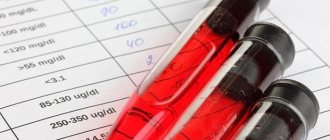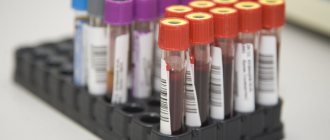Complexes with this research
Pancreas 1,750 RUR Composition
Entry into IVF Examination when a woman enters the IVF procedure 23,020 RUR Composition
Male check-up No. 1 39 studies for annual preventive examination RUR 18,570 Composition
IN OTHER COMPLEXES
- Pregnancy planning. Clinical indicators 6,630 R
- Biomarkers of liver functional capacity. Extended examination RUB 3,900
- Female infertility RUB 16,210
- Metabolic profile RUB 5,900
- Examination during pregnancy. 3rd trimester 9,620 RUR
When to get tested for diabetes
The content of the article
Diabetes mellitus is a dangerous endocrine disease that can be asymptomatic for a long time. The development of this endocrine disorder can be suspected by such signs as constant thirst, increased urination, increased appetite, and a sharp change in body weight. In this case, you should immediately contact an endocrinologist who will prescribe a set of tests for diabetes.
The most characteristic sign of diabetes is elevated blood glucose. Blood is taken from a finger on an empty stomach.
Detailed description of the study
Carbohydrates are important nutrients needed to keep the body functioning. They are divided into simple and complex. Complex carbohydrates are broken down into simple carbohydrates during digestion.
Glucose is the main carbohydrate needed by the human body. It serves as the most important energy resource for the brain and muscles. In its structure, glucose belongs to simple carbohydrates, along with fructose.
Upon entering the body, foods containing carbohydrates begin to break down in the oral cavity, where the enzyme amylase is found in saliva. They enter the stomach and then into the small intestine, into the lumen of which pancreatic juice is secreted. This juice contains many enzymes necessary to break down complex carbohydrate molecules into glucose.
Because this carbohydrate is so important for maintaining vital functions, the body stores a certain amount to prevent deficiency. Glucose is deposited in the form of glycogen. This process occurs inside liver cells - hepatocytes. When needed, glycogen is converted back to glucose. When glucose reserves in the form of glycogen are depleted, the body can synthesize it from substances contained in muscles and adipose tissue, which is called “gluconeogenesis.”
It is important to maintain blood glucose levels at a certain level. This is possible due to the action of a number of hormones, among which the most important is insulin. It is formed in the endocrine part (the so-called islets of Langerhans) of the pancreas in response to glucose entering the blood and regulates its transport into the cell.
If the body does not produce enough insulin, there is excess glucose in the blood, which leads to the development of diabetes. This disease is associated either with the destruction of pancreatic tissue (mainly in type 1 diabetes) or with a violation of glucose transport into the cell (insulin resistance), which is typical for type 2 diabetes.
Clinical manifestations of diabetes mellitus include: increased thirst, along with frequent urination, changes in appetite (it can decrease or increase). A prolonged increase in blood glucose causes pathological changes in the structure of the smallest vessels (capillaries), which contributes to a wide range of diabetes complications.
A sharp change in blood glucose levels can have life-threatening consequences. In severe cases, consciousness is impaired and coma develops. However, much more often the development of diabetes mellitus is preceded by impaired glucose tolerance, or prediabetes, when the glucose level is not yet so high as to speak with certainty about diabetes.
Changes in carbohydrate metabolism during pregnancy deserve special attention. The development of the placenta, which is a hormone-producing organ, and general changes in a woman’s body during this period can lead to gestational diabetes mellitus, that is, diabetes in pregnant women. Glucose levels usually return to normal after the baby is born.
Blood glucose levels are considered important biochemical indicators. Its determination is carried out both for preventive purposes and to control the course of the disease. Blood glucose levels can be tested in the Hemotest laboratory. Preparation is necessary - the study is carried out on an empty stomach, blood is taken from a vein.
Glucose level test
Table of contents
- Rules for preparing for the test
- What can affect the result?
- Analysis result
- Additional Research
- Which doctors refer you for the study?
- MEDSI cares about its patients
A glucose level test
is prescribed to identify and further control diabetes mellitus of all types, as well as other pathologies associated with impaired carbohydrate metabolism.
Biological material:
venous blood (serum or plasma), capillary blood
Glucose is an important carbohydrate in the human body, providing it with energy. Together with food, glucose enters the bloodstream. Its level in the blood is regulated by the activity of the neuroendocrine system and internal organs: kidneys and liver. To control glucose levels, the pancreas produces the hormone insulin, which helps it penetrate muscle, fat and liver cells. Along with insulin, hormones with opposite effects are involved in the regulation of glucose levels: glucagon, cortisol, adrenaline, somatotropin, thyroxine.
Taking the test is recommended when:
- Elevated glucose levels pose a risk of heart attack and stroke
- Diagnostics allows us to identify a number of diseases caused by impaired carbohydrate metabolism in the body and monitor the treatment of detected pathological conditions, such as type 1 and type 2 diabetes
It is especially important to get tested in the following cases:
- overweight
- sedentary lifestyle
- high blood pressure
- chronic liver diseases
- cardiac ischemia
- in preparation for and during pregnancy
Rules for preparing for the test
- Food.
It is necessary to abstain from food for 8–12 hours - Loads.
You should refrain from increased physical and psycho-emotional stress - Alcohol.
Alcoholic drinks should be avoided at least 24 hours before the blood donation procedure.
What can affect the result?
A physiological increase in concentration that
usually resolves within 2 hours, may be caused by:
- short-term physical activity (long-term, on the contrary, leads to a decrease in the level)
- stressful situations due to the release of catecholamines into the blood
- recent large intake of carbohydrates from food
Drug-induced increase in concentration
causes the intake of caffeine, adrenaline, narcotic and sleeping pills, diuretin, oral contraceptives and other drugs.
An increase in blood glucose levels can also be provoked by glucocorticoids, inhaled steroids, and statins.
In addition, medications against depression, anxiety and other mental disorders may change the results of the study.
Glucose levels increase when high doses of non-inhaled drugs for asthma and high blood pressure, cough syrups, etc. are prescribed. Aspirin, quinine, magnesium salicylate, etc. contribute to a decrease in the level.
Decreased concentration levels
glucose may also be due to
a number of reasons:
- long break between meals, fasting
- long physical work
- pregnancy, lactation
- overdose of antidiabetic drugs, insulin
It's important to keep in mind
that only a doctor who is aware of the medications the patient is taking can correctly interpret the diagnostic results. Therefore, in many cases, it is important to consult a doctor for advice before taking the test. The test result is also assessed by the doctor in comparison with the patient’s clinical picture.
If necessary, the specialist will refer the patient for other examinations. Based on the results of a comprehensive diagnosis, an accurate diagnosis will be made.
We recommend that you consult a doctor or undergo a check-up (a full examination program). To make an appointment with a doctor and take a test, as well as to clarify its cost, call +7 (495) 7-800-500. Our specialist will answer all questions and suggest the optimal time to visit the clinic. Recording is also possible through the SmartMed application.
Analysis result
Reference values (normal blood glucose)
| Age | Reference values |
| less than 14 years old | 3.3 – 5.6 mmol/l |
| children over 14 years old, men, non-pregnant women | 4.1 – 6.1 mmol/l |
| pregnant women | 4.1 – 5.1 mmol/l |
Causes of elevated glucose levels include:
- diabetes mellitus type 1 and 2
- severe stress
- chronic renal failure
- pancreatitis
- pancreas cancer
- hyperthyroidism
- acromegaly
- Itsenko-Cushing syndrome
- taking certain medications
Causes of decreased glucose levels In the pathological process, decreased levels are most often caused by excessive insulin secretion (hyperinsulinism), which may indicate pathology of the pancreas, endocrine glands that produce hormones that “inhibit” insulin production.
- alcohol abuse
- adrenal insufficiency
- hypothyroidism
- starvation
- insulin overdose
- liver disease
- insulinomas
Additional Research
Additionally, the patient may be referred for tests to determine:
- glucose in urine
- glycated hemoglobin
- GTT
- TSH
- catecholamine
- insulin
- serum c-peptide
- albumin in urine
- antibodies to GAD
Which doctors refer you for the study?
Referrals for diagnosis can be made by: general practitioner, pediatrician, endocrinologist, gastroenterologist.
MEDSI cares about its patients
- Experienced doctors will see you.
Our specialists professionally take biological material and examine it, which guarantees diagnostic accuracy - All our clinics offer comfortable conditions for taking the test.
- Testing is performed on high-precision expert-class equipment
- There is an opportunity to undergo a multidisciplinary examination
- Convenient location of clinics
To make an appointment with a doctor and take a test, as well as to clarify its cost, call +7 (495) 7-800-500. Our specialist will answer all questions and suggest the optimal time to visit the clinic. Recording is also possible through the SmartMed application.
Hormone tests for diabetes
To determine the type and degree of diabetes, a blood sugar test alone is not enough. Diabetes occurs in a latent form, when blood glucose levels remain normal, but other parameters have some deviations.
In addition to insulin, the hormones TSH (thyrotropin), glucagon, somatotropin, adrenaline, cortisol, T3 (triiodothyronine) and T4 (thyroxine) are responsible for converting glucose into energy that fuels tissue cells. Deviations from the normal concentrations of these hormones affect glucose metabolism and lead to hyperglycemia, a severe complication of diabetes that is life-threatening.
- Hormones T3 and T4
are produced by the thyroid gland and are involved in the regulation of metabolism. Lack of hormones leads to hypothyroidism, which is characterized by loss of strength, a feeling of exhaustion, and lack of energy. An excess of T3 and T4 leads to increased excitability, activation of all life processes, sleep disturbances, severe weight loss, nervousness - hyperthyroidism. - The hormone TSH
is produced by the pituitary gland; it “monitors” the activity of T3 and T4. If the thyroid gland is “lazy,” TSH rises and stimulates the thyroid gland. With excessive activity, the hormone level, on the contrary, drops. An increase in TSH with normal T3 and T4 levels indicates the initial stage of diabetes mellitus. - Cortisol and adrenaline
are stress hormones. They activate the body, making glucose more accessible to cells. But an increase in indicators indicates a high risk of diabetes. A high level of cortisol in the blood indicates that a person has been under stress for a long time, although he often does not notice it.
Such stress can be a psychotraumatic situation, a food diet, moving, coffee abuse, etc. If in a calm state the body first takes energy from carbohydrates, then from fats and only then from proteins, then under stress muscle tissue is consumed. The body sounds the alarm and demands “sweets”, which reduces cortisol levels for a while. Gradually, cortisol reduces the production of insulin, and then leads to the fact that energy is taken not from glucose, but from muscle protein tissue.
With stress, there is a high incidence of type 2 diabetes.
Adrenaline is also produced by the adrenal cortex in stressful situations. Unlike insulin, it increases the concentration of sugar in the blood. An increase in adrenaline is promoted by an excess of the hormones T3 and T4; everything in the human body is interconnected. Because adrenaline takes glucose from glycogen (the energy stores of the liver and muscles) rather than from the blood, blood sugar levels remain high.
The hormone glucagon is involved in maintaining normal blood sugar levels. In a healthy person, during intense physical activity, glucose levels drop, and glucagon breaks down reserves from the liver. In diabetes, insufficient insulin is produced, and glucagon ceases to participate in glucose synthesis.
Somatotropin or growth hormone is an insulin antagonist. But the increase in somatotropin does not always occur naturally. To speed up the growth of piglets and calves, farmers inject animals with artificial growth hormone. It enters the human body with food, helping to reduce the body's sensitivity to insulin.
Glucose tolerance test (glucose fasting, 1 hour and 2 hours after exercise)
This test is designed to diagnose hidden disorders of carbohydrate metabolism. The initial or latent form of carbohydrate metabolism disorder can manifest itself:
- in a slight increase in fasting glucose concentration, not exceeding the diabetes threshold;
- in the appearance of glucose in the urine with normal fasting blood testing;
- in the absence of glucose in the urine and normal blood counts, but in the presence of symptoms of diabetes (abnormal thirst and dry mouth, constant feeling of hunger, frequent urination);
- the appearance of glucose in the urine in pregnant women suffering from liver diseases;
- with thyrotoxicosis, infections, nerve disease or damage to the retina for no apparent reason.
In these cases, a glucose tolerance test is performed to clarify the clinical picture. It includes a number of manipulations:
- blood sampling to determine fasting blood glucose levels;
- taking a glucose solution (to prepare it, 75 g of anhydrous glucose is dissolved in 250-300 ml of water) no more than five minutes after taking a blood sample;
- repeated blood sampling after 60 minutes to determine the glucose concentration after simulating a meal (load);
- after 120 minutes, repeated blood sampling to determine the glucose concentration after exercise.
When it enters the blood, glucose stimulates the production of insulin, after which its absorption by tissues begins. Thus, 2 hours after exercise, the blood glucose level in healthy people returns to normal and drops below 7.8 mmol/l. In diabetics, this figure exceeds 11.1 mmol/l. Values varying within these limits indicate impaired glucose tolerance or a prediabetic state.
Disorders of carbohydrate metabolism are explained by two reasons: on the one hand, there is a failure in the production of insulin, on the other hand, tissues lose sensitivity to it. The indicator reflecting the fasting glucose level is not always high during the test - sometimes it corresponds to the norm or exceeds it slightly. In 30% of people with impaired carbohydrate metabolism, the indicators may return to normal values after a while, but this is not a guarantee of normal health. Impaired glucose tolerance can develop into type II diabetes.
Impaired glucose tolerance can be caused by metabolic syndrome, a set of conditions that are risk factors for the development of cardiovascular diseases. Metabolic syndrome is characterized by high blood pressure, high low-density lipoprotein (LDL) cholesterol, and low high-density lipoprotein (HDL) cholesterol. To relieve carbohydrate metabolism disorders, you need to lead a healthy lifestyle, fight excess weight, increase physical activity and eat right.
Pathological changes in blood sugar levels can occur during pregnancy. According to available data, gestational diabetes is detected in 14% of women. This is explained by the increasing load on the body as the child develops and the increased need for insulin, the production of which may be insufficient during this period. Pregnant women who:
- gestational diabetes was observed in a previous pregnancy;
- body mass index above 30 kg/m^2;
- closest relatives suffer from diabetes;
- children were born weighing from 4.5 kg;
- there were miscarriages;
- there have been cases of stillbirth;
- children were born with developmental defects;
- premature births were observed.
For adults with a body mass index above 25 kg/m^2 and the presence of at least one risk factor (see in the “Indications” section), it is necessary to undergo examination:
- 1 time every 3 years if a normal result is obtained;
- Once a year for impaired glucose tolerance or elevated fasting glucose levels.
For men and non-pregnant women over 45 years of age with normal weight and in the absence of risk factors, it is advisable to carry out the test at least once every 3 years.
If, as a result of checking your fasting glucose level, the indicator was twice above 7 mmol/l, then there is no point in performing a glucose tolerance test, since this in itself indicates a high probability of diabetes mellitus.
It is prohibited to conduct an examination:
- after surgical operations;
- after myocardial infarction;
- after childbirth;
- in the acute phase of the disease (including infectious);
- with a fasting glucose concentration exceeding 11.1 mmol/l;
- less than three days after using drugs that increase blood sugar (glucocorticoids, thyroid hormones, thiazide diuretics, beta blockers, oral contraceptives).
Based on the results of the study, it is impossible to determine the type and causes of diabetes mellitus, therefore, after receiving the result, you must consult an endocrinologist. On the recommendation of a doctor, a determination of glucose tolerance may be prescribed in parallel with the determination of the level of C-peptide, on an empty stomach and 120 minutes after taking glucose (item 642 in the list of laboratory tests carried out by Medical). This combination of tests allows you to determine the secretory reserve of insulin.
Four blood tests for sugar: conditions and norms in tests for diabetes
Since the main sign of the development of diabetes mellitus is an increase in blood glucose levels, the analysis will first include the following laboratory tests:
- Fasting blood glucose level analysis.
The most informative and accurate method for determining blood sugar levels. The essence of the study is to determine the concentration of glucose in the blood of a patient who has not eaten for at least 8 hours before the test. The norm is considered to be 3.5-5.5 mmol/liter, up to 6.9 mmol is a pre-diabetic state, over 7 mmol/liter indicates diabetes. - Analysis of blood glucose levels at a randomly selected time
. Unlike the first method, this study involves taking blood at any time of the day, regardless of food intake. It is important to understand that a value exceeding 11.1 mmol/l is considered dangerous, especially if such a high concentration is determined when the test is repeated. - Determination of glycosylated hemoglobin
. An important study that, unlike previous tests, makes it possible to assess blood glucose levels not at a specific moment of measurement, but over a period of 3-4 months. This opportunity arises due to the combination of blood hemoglobin and glucose, which persists and is detected for a long time. This analysis is recommended by WHO as a mandatory step in diagnosing diabetes mellitus. - Glucose tolerance test
. The study is based on the fact that after a load (taking a glucose-containing solution), the body begins to actively synthesize insulin in the pancreas, which leads to a decrease in blood sugar levels. Already two hours after the load, no more than 7.8 mmol/l glucose is determined in the blood of a healthy person. If the result of a glucose tolerance test is a glucose level above 11.1 mmol/l after 2 hours, the doctor may suspect carbohydrate metabolism disorders, in particular diabetes mellitus.







